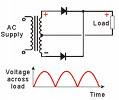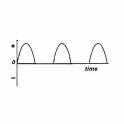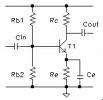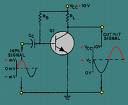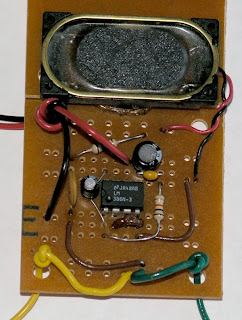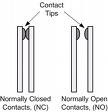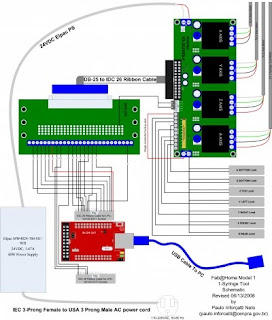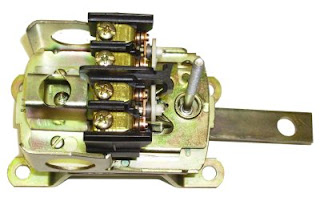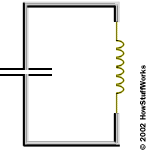diodes,mercury arc values and other components
If we wants to convert direct current(dc) into alternative current(ac) this device is known as inverter.
The type of rectifier are determine by the number of diode used in specific arrangement of diode There are following type of rectifiers which are only the uses of diode :
- half- wave rectifier
- full-wave rectifier
- bridge rectifier
In the half-wave rectifier ,only one either positive part or negative part of AC wave is passed.It is depends upon the uses of diode in positive half of transformer or negative half of transformer in series .It is very inefficient ,because only one half signal is reaches in output section of it .Half-wave rectification is achieved with the help of three diode in three-phase system and with the help of one diode in one phase system.
The output of DC voltage of half of rectifier can be calculated by followings theoretical equations.
- Vpeak=Vrms*1.1414
- Vdc=Vpeak/3.14
Half-Wave Rectifier:
According to the diode action ,the rectifier conducts signal (i.e current) only at the time of positive half cycle of input a.c signal where as the negative half-cycle of a.c signal are cutoff or suppressed. At the time of negative half-cycle ,no current conduct in the circuits.Therefore no voltage drop across the lad resistor.That's why,signal (i.e current ) always flows in only one direction (i.e d.c signal) via the load resistor after every half-cycles.
Circuits Explains:
It consists of one diode ,transformer and load with complete close circuits.So this single S/C diode acts as a half-wave rectifier.The a.c signal which is going to rectified is applied in series with the signal diode and load resistance as shown in above.Usually ,a.c supply is applied via a transformer .By the transformer action ,It has two advantages ,one is it allows at step up or step down the a.c input signal as our desire and other is it isolates the rectifier circuits form power line and therefore it decrease the risk of electric shuck in the circuits or equipments.
Working Explain:
The applied a.c signal across the secondary winding change polarities after each half -cycle of supply a.c voltage.At the time of the positive half-cycle of supply a.c voltage,upper end of secondary windings becomes positive w.r.t the lower end of its.In this condition diode is in forward biased and it conduct current in the circuits.At the time of negative half-cycle of in put a.c voltage ,upper end of secondary windings is negative w.r.t the lower end of its.In this condition ,diode becomes reverse biased and it does not conduct current in the circuits.In this way, current flows via the load at the time of positive half-cycle of input a.c voltage only where as no conduct current through the load at the time of negative half-cycle of supplied a.c voltage in the same direction is obtain across load for other next cycle.But this output is pulsating d.c .Hence to reduce it an extra filter circuits is used .
Limitations:
- The output is low because a.c supply delivers power only half-cycle time
- To remove pulsating d.c it required extra filter circuits .
Full-Wave Rectifier:
In this full-wave rectification,two diode are used in such way that they work alternately.Current flows via the same direction at the time of both half-cycle of input a.c voltage .During the positive half-cycle of input a.c voltage one diode conduct current through the load and during the negative half-cycle of the input a.c voltage ,next one diode conducts current via load in same direction.In this way full-wave rectifier circuits utilises the both half-cycle of input a.c voltage to produce the d.c output .Therefore its efficiency is higher than half-wave rectifier.
Center-Tap Full-wave Rectifier:
Circuits details:Working Explains:
At the time of positive half-cycle of secondary winding voltage ,the upper end of secondary winding becomes positive w.r.t the lower end of its.Under this condition ,upper diode is in forward biased whereas lower diode is in reverse biased.Hence upper diode conduct positive half-cycle of the input of the a.c voltage where as lower diode does not conducts.At the time of negative half-cycle of secondary winding ,upper end of secondary winding become negative w.r.t the lower end of its.Under this condition ,lower diode is in forward biased where as upper diode is in reverse biased.Hence the lower diode conduct current via load of the negative half-cycle of input a.c voltage and upper diode does not conducts current .The current in the load is in same direction for both half-cycle of input a.c voltage.In this way d.c output is obtain across the load .
Limitations:
- It is difficult to locate exact the center tap on the secondary winding of transformer.
- The diode used must have large peak inverse voltage.
- Each diode utilises only one half-cycle of secondary voltage,so the d.c output is small.
It consists of four diode ,transformer and load resistor connected as shown in figure below .The a.c signal is applied to the diagonally opposite ends of the two diode whereas another two ends of the diode is connected to the load resistor as shown in figure.
At the time of positive half-cycle of secondary winding voltage the upper end of the secondary winding becomes positive w.r.t the lower end of its.Under this condition diode D1 and D4 are in forward biased where as other diode are in reverse biased .Hence the diode D1 and D4 conduct current through the load resistor.
At the time of negative half -cycle of the secondary winding voltage ,the lower end of the secondary winding is positive w.r.t the upper end of the secondary winding .Under this condition , D2 and D3 are in forward biased and where as other diode are in reverse biased .Hence the diode D2 and D3 conduct current through the load resistor .This flows of current is in same direction as for positive half -cycle of the secondary winding voltage .Hence d.c output is obtain across load resistor.
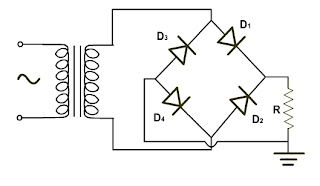
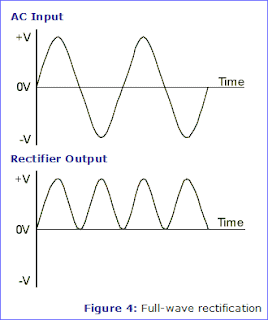
Advantages:
- No required of center-tap transformer
- For the same secondary winding voltage the output is twice that of center-tap full wave rectifier circuit.
- For same d.c output ,the PIV is one-half of that of center tap full wave rectifier.
- Four diode are need for this circuit.
- The voltage drop in the internal resistance is twice as in the center tap full wave rectifier circuits because of four diode.


